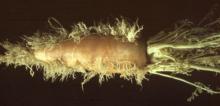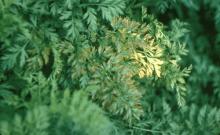See:
Carrot (Daucus carota) - Carrot Purple Leaf
Cause Candidatus (Ca.) Phytoplasma asteris, which is spread by leafhoppers. Phytoplasmas survive the winter on weed hosts. Aster yellows also occurs in lettuce, endive, tomato, parsley, onion, squash, salsify, many weeds, and several ornamental flowering plants.
Symptoms New leaves in the plant's heart are yellow, reduced in size, deformed, and dense in growth. Older leaves may have a purple or reddish color. Carrot roots frequently are deformed and develop dense tufts of hair-like rootlets. Dormant buds in the crown may develop so the plant takes on a witches' broom appearance.
Cultural control
- Remove infected plants as soon as they are detected.
- Control measures against the leafhopper vectors have reduced disease in some areas but are economical only in areas with significant crop losses. For details of materials and application rates, see the PNW Insect Management Handbook.
Reference Frost, K.E., Esker, P.D., Van Haren, R., Kotolski, L., and Groves, R.L. 2013. Factors influencing aster leafhopper (He-miptera: Cicadellidae) abundance and aster yellows phytoplasma infectivity in Wisconsin carrot fields. Environmental Entomology 42:477-490.



